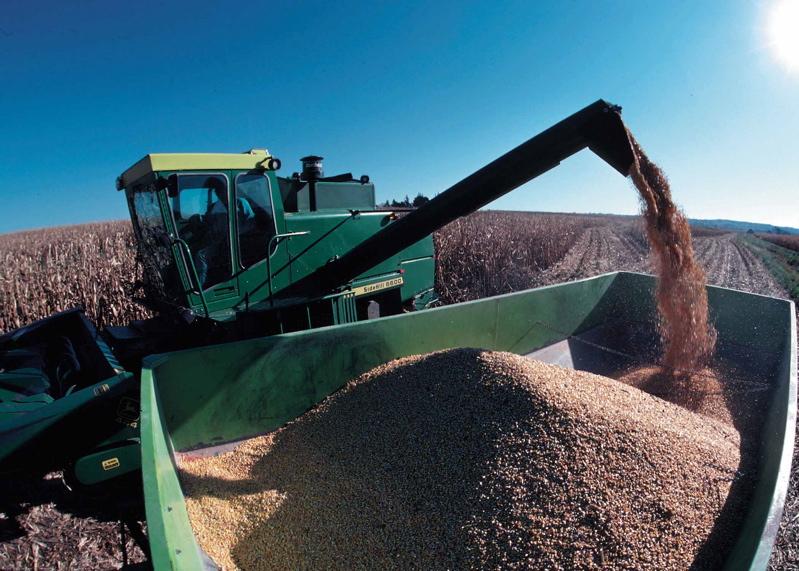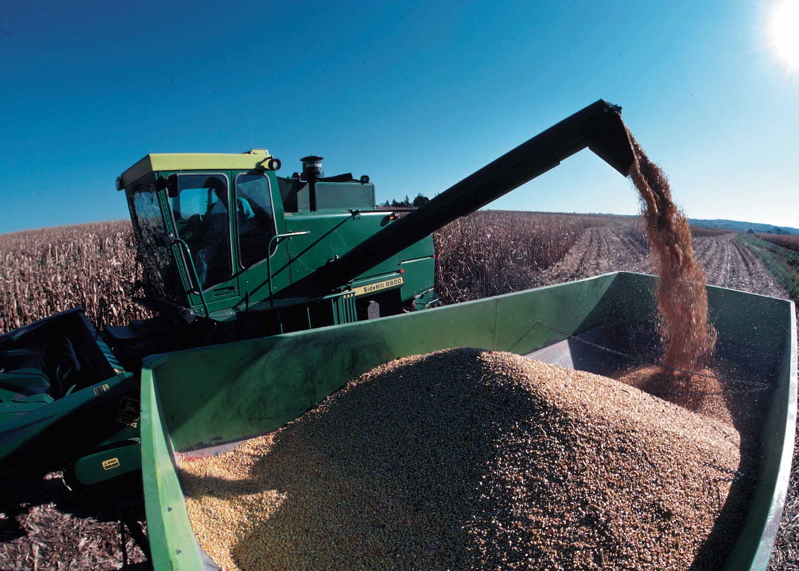 Corn harvest in Iowa. Would you like that in your Big Mac, your gas tank, or both?Photo courtesy of USDA NRCS. What do industrially produced meat and corn-based ethanol have in common?
Corn harvest in Iowa. Would you like that in your Big Mac, your gas tank, or both?Photo courtesy of USDA NRCS. What do industrially produced meat and corn-based ethanol have in common?
Well, they both thrive on the assumption that it’s good idea to devote vast swaths of land to an incredibly resource-intensive crop–corn–and then run that crop through an energy-sucking process to create a product of dubious value.
And … they both got tagged as major drivers of climate change this past week.
Ethanol took the harder blow of the two, I think. It came wrapped in the Oct. 23 issue of Science. In a concise and devastating “policy forum” piece, a team of authors led by University of Minnesota researcher Tim Searchinger fingered a gaping defect in existing European and pending U.S. climate policy: biofuel gets treated as carbon-neutral, ignoring carbon emissions from land-use change. According to the paper ($ub req’d), the Kyoto Protocol, the European Union’s cap-and-trade law, and the final version of Waxman-Markey (the House climate bill that passed over the summer) all contain the a “far-reaching but fixable flaw”:
[They] does not count CO2 emitted from tailpipes and smokestacks when bioenergy is being used, but it also does not count changes in emissions from land use when biomass for energy is harvested or grown. This accounting erroneously treats all bioenergy as carbon neutral regardless of the source of the biomass, which may cause large differences in net emissions. For example, the clearing of long-established forests to burn wood or to grow energy crops is counted as a 100% reduction in energy emissions despite causing large releases of carbon.
Or, as Searchinger put it to a Wall Street Journal reporter, “Literally, in theory, if you chopped up the Amazon, turned it into a parking lot, and burned the wood in a power plant, that would be treated as a carbon-emissions reduction strategy.”
The implications of the flaw are staggering: existing climate law, coupled with U.S. and European biofuel mandates, could lead to vast forest clearing–unleashing a gusher of greenhouse gases in the name of … averting climate change. That’s sort of like trying to save your sight by gouging out your eyes. The authors state:
One study estimated that a global CO2 target of 450 ppm under this accounting would cause bioenergy crops to expand to displace virtually all the world’s natural forests and savannahs by 2065, releasing up to 37 gigatons (Gt) of CO2 per year (comparable to total human CO2 emissions today). Another study predicts that, based solely on economic considerations, bioenergy could displace 59% of the world’s natural forest cover and release an additional 9 Gt of CO2 per year to achieve a 50% “cut” in greenhouse gases by 2050. The reason: When bioenergy from any biomass is counted as carbon neutral, economics favor large-scale land conversion for bioenergy regardless of the actual net emissions. [Emphasis added.]
It should be noted that this “flaw” in U.S. climate policy is no accident. House Ag committee chair Collin Peterson fought like a pitbull to enshrine it in Waxman-Markey. To the agribusiness lobby Pererson represents, tarnishing the good name of ethanol is tantamount to setting fire to a Bible during Sunday school.
Another article in the same Science issue explores another massive problem with biofuels: water scarcity. As the author puts it: “A widespread shift toward biofuels could pinch water supplies and worsen water pollution. In short, an increased reliance on biofuel trades an oil problem for a water problem.” (Emphasis added.) According to the author, it takes between 90 and 190 liters of water to extract a kilowat-hour worth of oil. To get thhe same amount of energy from corn–based ethanol? Try 2.2 and 8.6 million liters of water. Ouch.
As for meat, get this: two researchers associated with the World Bank claim in a new World Watch piece (PDF) that meat production is responsible for more than half of global greenhouse gas emissions. Previously, the most widely cited estimate came from the FAO, which reckoned meat contributes an already-stunning 18 percent.
So why the difference in assessments? The biggest factor is respiration–the breathing out of C02–by livestock. According to the authors, livestock respiration adds massive carbon to the atmosphere–that factor alone, they claim, is equal to 13 percent of global annual GHG emissions.
I don’t have the scientific chops to assess their reasoning. I do wonder if the vast number if the C02 breathed into the air by farm animals isn’t partially offset by the vast number of wild animals elimainated by meat production. It’s not a pretty thoughtm but think of the habitat swallowed up by corn and soy fields globally–and the billions of animals who now monger exist to breathe out carbon.
However, I agree that meat production is deeply implicated in climate change–and must be cut dramatically. But I find these authors’ conclusion stunning: They want to replace industrially raised meat with industrially raised soy. In place of a chicken in every pot, they want to see a “chicken” in every pot. They call on the food industry to dramatically scale up the production of highly processed fake meat–and even offer marketing advice. They declare:
A successful campaign would avoid negative themes and stress positive ones. For instance, recommending that meat not be eaten one day per week suggests deprivation. Instead, the campaign should pitch the theme of eating all week long a line of food products that is tasty, easy to prepare, and includes a “superfood,” such as soy, that will enrich their lives.
They also express enthusiasm for “artificial meat cultivated in laboratories from cells originating from livestock, sometimes called ‘in vitro’ meat.”
Sorry, but given ideas like that, I’m not ready to let a couple of World Bank guys dictate the future of cuisine. Getting a carnivorous culture to reduce meat consumption is going to be tricky no matter what. Rather than push folks to embrace soy weenies and test-tube “shmeat,” I’d rather see a revival of minimally processed rice and beans, a move toward meat as a side dish, and a return to diversified farming that uses manageable amounts of manure to nourish cropland. Let’s ban the CAFO–but not eviscerate what’s left of our palates.


